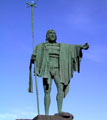Guanche social structure and political organisation before the conquest.
 The Guanche society was patriarchal and divided into social groups defined by wealth, mainly considered as land and livestock. In Tenerife there was an aborigine noble class that was composed of:
The Guanche society was patriarchal and divided into social groups defined by wealth, mainly considered as land and livestock. In Tenerife there was an aborigine noble class that was composed of:
- Mencey: king or monarch of each territory on the island or of the whole island
- Achimencey: or governer, a noble class made up of privileged castes in the political as well as the religious areas, participation in government decision making.
- Guañameñes or Guadameñas : the high priests of the Menceyatos
- Chaureros o Tagoreros : magistrates and managers of the different Auchones
- Sigoñes or captains
- Cichiciquitzos or the warriors: destined for handling the weapons.
- Achicaxna : people dedicated to livestock raising and agriculture
- Achicaxnais: those dedicated to domestic duties (millers, fishermen, potters, etc).
- Embalsamers were the lowest class.
The menceyato or Guanche kingdom had its forms of governments, where the death penalty did not exist, the thief was severely punished, as well as he who disrespected women, the homicide had his worldly goods taken away from him and was exiled from the menceyato.
These menceyatos were made up of auchones (dwellings, that meant houses, huts and corrals, in which the civilian family lived together with their livestock, completely separate from the other families), tagoros (a kind of senate or parliament, a meeting place to discuss war issues, as well as justice, moral and religious issues and anything else related to the general management), in each one of the existing menceyatos their beliefs and rites were freely expressed.
The Guanche population settled preferentially in the region of Anaga, where caves and natural grottos were abundant, there was more pasture land for the livestock and a relative abundance of fresh water in the valleys of the northern slope, which favoured the establishment of more stable and numerous settlements.
These settlements took on the form of villages, made up of buildings with a primitive architectural structure, generally of circular shape, stone walls and thatched roof. In high and difficult to reach places there were also natural caves or volcanic tubes, excavated caves or rudimentary cabins for occasional use.
The main activity was shepherding, but they also dedicated themselves to agriculture, recollection, fishing, or craftsmanship. Material culture was rudimentary, since stone, clay, animal pelt or wood, were the main raw materials.
About one hundred years before the conquest the last great Mencey of Tenerife, there ruled Tinerfe, the great son of the Mencey Sunta. Tinerfe had his court in Adeje and governed all the island, he had nine legitimate sons and one illegitimate, that later on rebelled and distributed the island in nine menceyatos (Tegueste, Tacoronte, Taoro and Iconden in the north, Guimar, Abona and Adeje in the south, Anaga in the east and Daute in the west) as well as one independent achimenseyato (cantón de La Punta) that was for his illegitimate son.